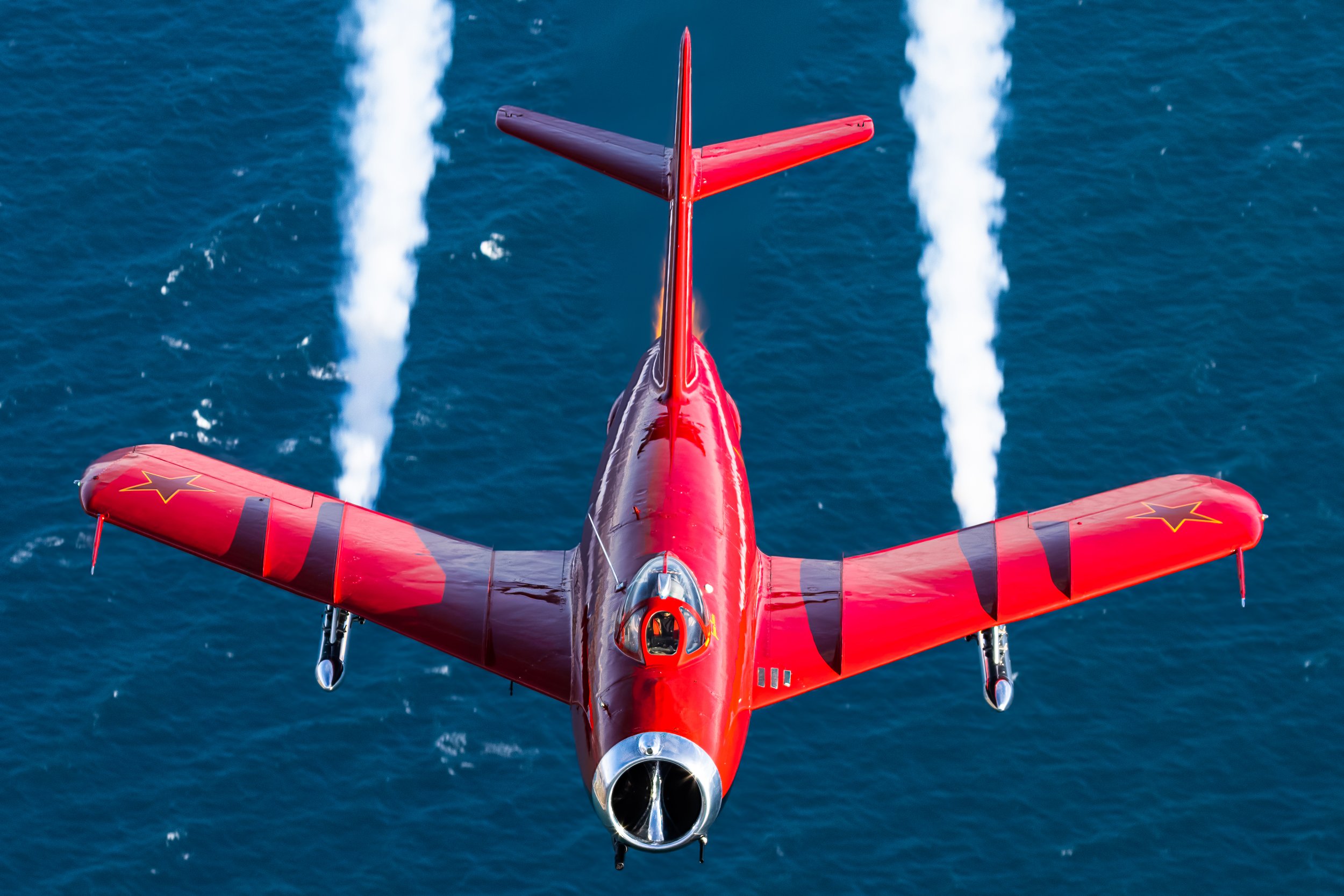
January 14 / MiG-17 first flight
First Flight 14 January 1950
Mikoyan-Gurevich MiG-17
The Mikoyan-Gurevich MiG-17, designated with the NATO reporting name “Fresco,” emerged from the Soviet Union’s ambitious post-World War II military aviation program. Its development began in the late 1940s, specifically in 1949, as the Mikoyan-Gurevich design bureau sought to create a successor to the highly successful MiG-15, which had made its mark during the Korean War. The MiG-15 was notable for its swept-wing design, which had proven effective in air combat, and the new fighter aimed to build upon this foundation while addressing the shortcomings identified during its predecessor’s operational deployment.
The MiG-17 was conceived as a high-subsonic fighter, intended primarily for intercepting slower, straight-flying bombers. The aircraft was designed to enhance maneuverability and performance at transonic speeds, recognizing the need for agility in aerial dogfights, particularly against the backdrop of the evolving air combat landscape of the early Cold War. It featured a series of design improvements over the MiG-15, including a thinner, more highly swept wing with a 45-degree sweep angle at the root and 42 degrees at the tip, which improved aerodynamic efficiency and control at higher speeds. The new design also incorporated a longer fuselage, a ventral fin for stability, and additional wing fences to enhance lift and control in various flight regimes.
The first prototype of the MiG-17, designated I-330 “SI,” took to the skies on January 14, 1950, under the skillful piloting of Ivan Ivashchenko. However, the development was not without its challenges. The aircraft suffered from issues such as aileron reversal and flutter, leading to tragic incidents, including the death of Ivashchenko when his aircraft experienced a catastrophic failure during testing. These setbacks prompted rigorous testing and modifications, resulting in a successful series of prototypes and the eventual acceptance of the MiG-17 for production on September 1, 1951.
Despite the initial promise of the MiG-17, its production was delayed as the Soviet Union prioritized the manufacturing of the MiG-15 to meet the immediate demands of the Korean War. It wasn’t until October 1952 that the MiG-17 entered service, just as the Soviet Union was on the brink of testing the more advanced MiG-19. The MiG-17 was characterized by its armament, which included three cannons: a 37 mm Nudelman N-37 cannon and two 23 mm cannons, allowing it to engage both bombers and enemy fighters effectively. Moreover, the aircraft had the versatility to function as a fighter-bomber, though its payload capacity was relatively modest compared to contemporaneous aircraft.
As the MiG-17 began to enter service, it underwent several modifications and variants, including the MiG-17F, which featured an afterburning engine that significantly enhanced its performance. The VK-1F engine allowed the aircraft to achieve improved climb rates and maneuverability, making it more competitive against faster adversaries. The introduction of radar systems in variants like the MiG-17P and MiG-17PF further expanded its capabilities, allowing it to engage targets in all-weather conditions.
By the mid-1950s, the MiG-17 had gained international recognition, and its design was licensed for production in several countries. Poland began manufacturing the aircraft under the designation Lim-5, while China produced the Shenyang J-5. These licensed versions contributed to a significant number of MiG-17s in service around the world, further solidifying its status as a staple fighter aircraft of the era.
The operational history of the MiG-17 is marked by its first combat engagements during the Second Taiwan Strait Crisis in 1958, where it faced off against the Republic of China’s F-86 Sabres. This conflict showcased the MiG-17’s effectiveness against slower, heavily laden American bombers and fighter-bombers, aligning with its original design intent. However, the aircraft’s limitations became apparent as the U.S. introduced faster and more advanced aircraft into the theater.
The MiG-17’s most notable combat experience came during the Vietnam War, where it was employed by the Vietnam People’s Air Force (VPAF) against American forces. The North Vietnamese pilots, initially trained in the People’s Republic of China, began transitioning to the MiG-17 in the early 1960s. The Soviet Union provided support, including a gift of MiG-17 fighters, which enabled the establishment of the VPAF’s first jet fighter regiments. As American air operations intensified, the MiG-17 emerged as a critical component of North Vietnam’s air defense strategy.
Despite being outclassed in speed and technology by American aircraft such as the F-4 Phantom and F-105 Thunderchief, the MiG-17 proved to be a formidable adversary in dogfights. Its agility allowed skilled North Vietnamese pilots to exploit the weaknesses of their American counterparts, leading to a series of notable engagements. The aircraft’s armament, which included cannons, provided an edge in close-range combat, particularly against American fighters that initially lacked similar capabilities.
Throughout the Vietnam War, the MiG-17 was responsible for several aerial victories, with North Vietnamese pilots achieving ace status while flying the aircraft. The tactical employment of the MiG-17, often in ambush-style attacks against unsuspecting American bombers and fighters, demonstrated the effectiveness of the aircraft in the hands of skilled pilots. The VPAF’s strategic use of the MiG-17, combined with the element of surprise, allowed them to inflict significant losses on American air operations, despite being numerically and technologically outmatched.
As the conflict progressed and the introduction of more advanced fighters like the MiG-21 occurred, the MiG-17 gradually transitioned to a secondary role within the VPAF. However, its legacy endured, as it remained operational in several air forces around the world, including North Korea, where it continues to be utilized even decades after its initial introduction.
The MiG-17’s design and operational history underscore its significance as a key player in the evolution of military aviation during the Cold War era. Its ability to adapt and remain relevant in various combat scenarios, coupled with its widespread production and deployment, solidified its place in the annals of aviation history. The aircraft’s design innovations and combat performance not only reflected the technological advancements of the time but also the shifting dynamics of air warfare in the face of rapidly evolving threats and challenges.
Mig-17 Facts
Design Origin: The MiG-17 was developed by the Mikoyan-Gurevich Design Bureau in the Soviet Union as an advanced modification of the MiG-15, primarily to address the shortcomings identified during its predecessor’s combat experience in the Korean War.
First Flight: The first prototype of the MiG-17, designated I-330 “SI,” made its maiden flight on January 14, 1950, piloted by Ivan Ivashchenko.
Production: Serial production of the MiG-17 began in August 1951, but it did not enter service until October 1952, as production was initially prioritized for the MiG-15.
Armament: The MiG-17 was armed with three cannons: one 37 mm Nudelman N-37 cannon and two 23 mm cannons, providing it with significant firepower for engaging both bombers and enemy fighters.
Variants: Numerous variants of the MiG-17 were produced, including the MiG-17F (with an afterburning engine), the MiG-17P (an interceptor with radar), and the MiG-17PF (all-weather fighter).
License Production: The MiG-17 was licensed for production in several countries, including Poland (as the Lim-5) and China (as the Shenyang J-5), resulting in thousands of aircraft being produced outside the Soviet Union.
Combat History: The MiG-17 saw its first combat during the Second Taiwan Strait Crisis in 1958, where it engaged Republic of China F-86 Sabres.
Vietnam War Role: During the Vietnam War, the MiG-17 became the primary interceptor for the Vietnam People’s Air Force (VPAF), achieving several aerial victories against American aircraft.
Agility: The MiG-17 was noted for its agility and manoeuvrability, which allowed it to perform well in dogfights against faster American jets, particularly in the close-range engagements typical of the Vietnam War.
Legacy: The MiG-17 remains in service with a few air forces, notably North Korea, and has been used in various conflicts around the world, reflecting its enduring design and adaptability.
















